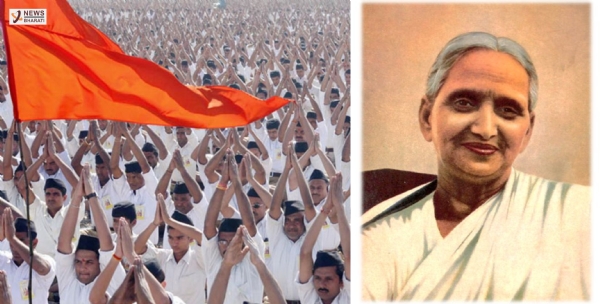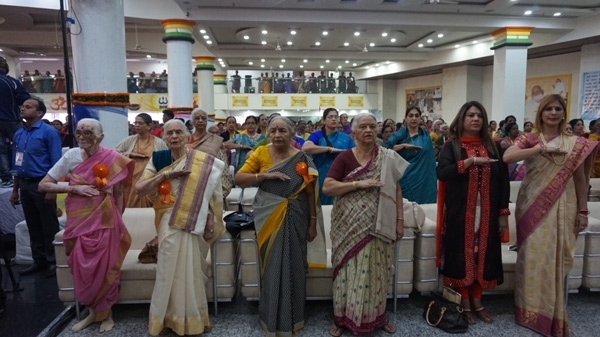Laxmibai Kelkar and foundation of Rashtra Sevika Samiti on Vijayadashmi
On Vijayadashmi day, in 1936, the Rashtra Sevika Samithi was formally inaugurated.
Total Views |
Vijayadashmi concludes the nine day long celebration of Navratri with a sense of victory of good over evil. The muhurta of Vijayadashmi is significant for Rashtriya Swayamsevak Sangha as its foundation day. The organization is often mistakenly associated with a male dominant ideal of 'seva' or 'service'. However, not many are aware about RSS's sister organization 'Rashtra Sevika Samiti' that is filled with young and old lady patriots who have been part of the Samiti functioning parallelly to the Sangha.

What one imagines while thinking about RSS is "Men dressed in white shirts with Khakee pants and black topi with a lathi in hand." And all that the RSS is thought about consists of 'men'. The other side of the story that has stayed out of societal recognition is that of the Rashtra Sevika Samiti; a dream that would have remained just a dream if it wouldn't have been for Laxmibai Kelkar.
Laxmibai Kelkar, who is affectionately known as 'Mausiji', is the pioneer who led to the establishment of the 'Rashtra Sevika Samiti'. She was born on July 6, 1905, with the name 'Kamal', in Nagpur to Bhaskar Rao Datey, who was a Government servant and Yashodabai, who was a Homemaker. It might be strange to know that Laxmibai completed her schooling from a 'Mission school' of colonial India and yet persisted with her love and dedication for Hindu culture. On her own terms and her parents will, Laxmibai later got married well known Advocate Purushottam Rao of the famous Kelkar family of Wardha. It was only then, after her marriage, when she was named 'Laxmibai'.
What she witnessed after marriage was a complete reversal of a reality she had wished for her post-marriage life. The atmosphere in her husband’s house was totally different from that of her parental home. The Kelkar family were British loyalists and her husband was modern in his outlook and visited the club to play billiards and socializing. However, he placed a number of restrictions on the womenfolk of his house. On the contrary, Laxmibai came from a background where she had enjoyed greater freedom. She was upset with the restrictions that were put on her at her in laws but she continued with her commitment as a Grihastcharini.
But on the positive side of the story, as her family had a history of barristers in a period when India was fighting its struggle for independence, she often got chance to witness intellectual discussions about India's freedom struggle, that kept the flame of patriotism in her soul burning. Besides, with Mahatma Gandhi's shift from Sabarmati to Wardha, the place became a hotspot of India's political movement, that further fueled Laxmibai's zeal to serve the nation. Unfortunately her husband was diagnosed with Tuberculosis which resulted in his death. He passed away leaving his young wife as a widow at the age of twenty seven. Besides, her elder daughter too died of the same disease. However, pushing aside her grief, she took over the management of the house and took control of the financial affairs of her home.
How much ever she was overburdened with her responsibilities at home, she never turned her back towards her responsibilities for her motherland. Laxmibai when realized that there was no school for girls in Wardha to admit her daughter, she took the first step in laying the foundation of a girl’s school and paved way for women’s literacy in Wardha. She searched for caring and dedicated teachers and provided them accommodation in her own home treating them like members of her family. She encouraged the girls to learn cycling and swimming. Besides, she also participated in the spinning programmes at Mahatma Gandhi's Sevagram, Prabhat Pheris, evening prayer meetings and question answer sessions.

While she was performing her duties for her motherland by the means of women's social upliftment and Sevagram, her sons joined the RSS where they were taught physical and mental discipline, art of warfare and many more things to live a righteous life, dedicated to the nation. Observing the change and discipline in her sons, Laxmibai realized a similar institution like that of the RSS is required where participation of women for Rashtraseva will be allowed. In this regard, she decided to meet Dr. Hedgewar, the head of the Rashtriya Swayamsevak Sangha.
In the 1930's, Laxmibai Kelkar met the founder of RSS, Dr. Hedgewar and expressed her keen interest to join the Sangha for Rashtraseva. Until then the RSS had no women volunteering for seva. It was a distinctive initiative taken by Kelkar. Dr. Hedgewar, realizing the zeal of women to serve the nation, motivated Mausiji to unite women who wish to perform 'seva' for the nation. And this is how, the Rashtra Sevika Samiti came into being with the zeal and determination of Laxmibai Kelkar and the guidance of Dr. Hedgewar. It was decided that although Samiti's ideology would be parallel to the Sangha, the Samiti would be autonomous and independent. On Vijayadashmi day, in 1936, the Rashtra Sevika Samithi was formally inaugurated.
--



